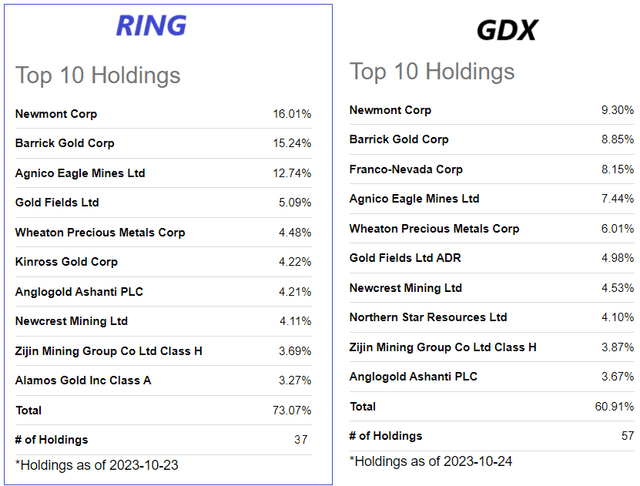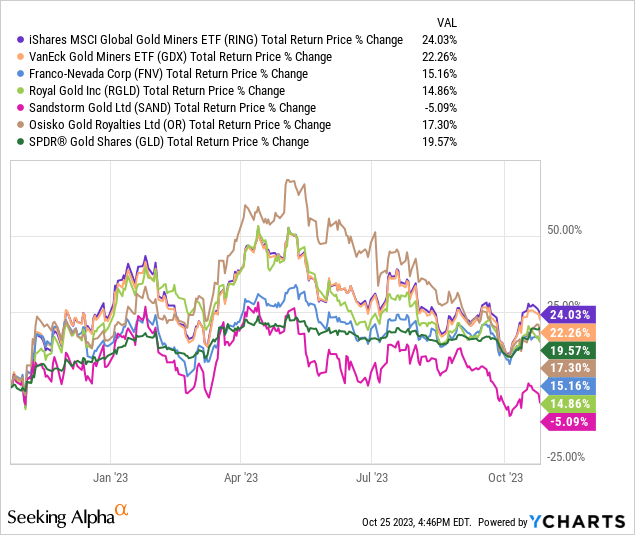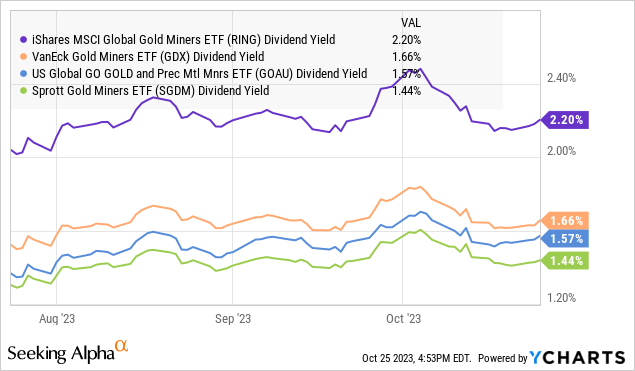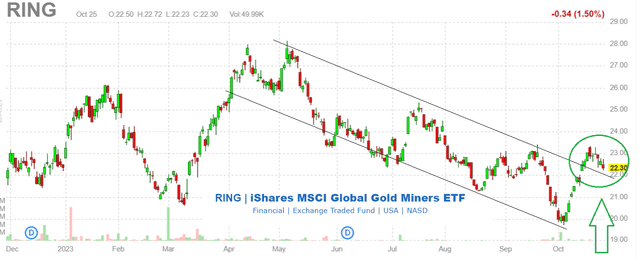The iShares MSCI Global Gold Miners ETF (NASDAQ:RING) invests across the leading precious metals producers. Even as the price of gold is currently trading just a few points from its all-time high, gold miners have underperformed facing wider swings of volatility. This is a segment that has been challenged by broader macro headwinds including inflationary cost pressures and rising interest rates.
That being said, the RING ETF stands out as outperforming its peer group of gold mining ETFs through its unique strategy. In this case, RING has benefited from a more concentrated portfolio within large-cap leaders that adds a layer of quality to the fund thereby balancing some of the risk.
In our view, RING is a good option for investors to gain exposure to the high-level trends in gold miners. With a bullish view on gold prices, we see RING as well-positioned to rally higher into 2024.

What is the RING ETF?
RING technically tracks the “MSCI ACWI Select Gold Miners Investable Market Index” which screens for companies that are active gold producers with otherwise unhedged exposure to underlying gold prices.
source: MSCI
The first implication here is that this aspect of the security selection process avoids gold stocks known as “streamers” players which essentially provide financing to gold producers in exchange for the right to purchase gold at a discounted price. The separate category RING attempts to exclude are “royalty” players that arrange a predetermined percentage of gold mining revenues.
The specific methodology of RING’s index also attempts to move away from exposure to companies that are non-revenue producing exploration or in just the development phase of gold assets. Naturally, this segment is recognized as more speculative with potentially higher rewards but falls out of the fund’s objective of concentrating on current gold production.
Finally, the strategy here features a free-float adjusted weighting methodology that is rebalanced quarterly.
source: iShares
Going through the portfolio, we mentioned the concentrated exposure with the current portfolio just holding 37 stocks. The top 3 investments between Newmont Corp (NEM), Barrick Gold Corp (GOLD), and Agnico Eagle Mines Ltd (AEM) together represent nearly 45% of the total portfolio weighting.
Still, there is a broad representation of global players including small-caps down the line. The idea here is to capture the high-level trends in gold mining and the understanding is that the large-cap players offer both geographic diversification with several mining sites along with solid fundamentals.
RING vs GDX
Here we can draw a contrast between the RING ETF and the more widely traded VanEck Gold Miners ETF (GDX). Notably, GDX is a materially larger fund with $11.6 billion in AUM compared to RING’s modest $400 million.
While both funds hold many of the same stocks, RING’s is distinct both for its more “top-heavy” portfolio where we mentioned the greater concentration among the largest investments.
Seeking Alpha
RING is also specifically excluding Franco-Nevada Corp (FNV) and Royal Gold Inc (RGLD) given both companies’ streaming and royalty-focused business model. Other names captured in GDX but not included in RING are Sandstorm Gold (SAND) and Osisko Gold Royalties (OR).
The reason this distinction is important is that the core business model of streamers and royalty names is often dependent on access to financing. In the current environment of higher interest rates, the cost of debt represents one headwind for this group to fund new deals.
It’s not a direct relationship and there are several moving parts, but we can highlight how these same streamers have underperformed RING and even the price of gold through the SPDR Gold Shares fund (GLD) over the past year. Curiously, RING does hold Wheaton Precious Metals Corp (WPM), recognized as a streamer, which appears to be an exception to the rule.

So while we won’t claim one fund or strategy is “always” better than another or that RING will outperform indefinitely, the takeaway here is that RING is simply a more “pure-play” on gold producers.
In terms of an advantage to GDX, the fund offers better liquidity daily which would make it suitable for short-term trading purposes. That said, investors with a longer-term profile may find RING’s lower expense ratio at 0.39% a positive compared to GDX’s 0.51% fee as a better alternative.
The other aspect where RING differentiates itself is through its higher dividend yield currently at 2.2%. This is above the 1.7% offered by GDX and also above other sector ETFs such as the US Global GO GOLD and Precious Metal Miners ETF (GOAU) and the Sprott Gold Miners ETF (SGDM).

What’s Next For RING
While the price action in mining stocks has likely frustrated investors over the last few years, it’s fair to say that gold has earned its reputation as a store of value and flight to safety asset amid the current macro environment.
Growing uncertainties regarding the strength of the global economy and the next steps in Fed policy have added to financial market volatility adding a boost of momentum to gold more recently. Indeed, gold trading at just under $2,000 an ounce is up more than 20% from its low in 2022 with a new round of bullish sentiment.
source: finviz
What’s more impressive here is that this trend has taken place while the Dollar has strengthened and real rates are up to the highest level in nearly two decades.
While those factors are historically seen as pressuring the value of gold, the argument we make is that an eventual reversal lower in the Dollar and a pullback in bond yields could mark a catalyst for the next leg higher in gold where mining stocks within the RING portfolio will participate to the upside.
Junior miners and more speculative small-cap gold players could outperform to the upside, but what we like about RING is its risk-adjusted profile and targeted positioning in actively mining companies.
The potential that RING rallies back just to its 52-week high above $28.00 could represent a return potential of 25% from the current level as our first price target. Into 2024, a scenario where a rally in gold accelerates can see gold mining stocks significantly higher as companies benefit from the improved earnings outlook driving an expansion of valuation multiples.
source: finviz
Final Thoughts
RING is a high-quality gold mining ETF that warrants a closer look by investors and is worthy of a position as a core holding in the context of a diversified portfolio.
In terms of risks, we believe it would take a breakdown in the price of gold below ~$1,750 to force a reassessment of the bullish outlook. Gold mining stocks could be subject to some contagion risk in a scenario of a deeper global recession adding to financial market volatility. Significantly higher inflationary cost pressures including energy prices would also undermine the earnings potential of mining stocks.
Read the full article here












